Dental Implants in Turkey are one of the most preferred operations for people all around the world that comes to Turkey for dental operations.
Dental implants Turkey are no different from those found elsewhere in the world. Procedures, components, implant types, etc. But why would you choose a deal in Turkey? Patients who had implants in Turkey chose this location mostly because of the extremely low prices and the high quality of the modifications. You will only need to visit Turkey twice, three months apart. Considering that you will do these operations by plane, even the cost will be very affordable for you.
The average cost of Dental Implants in Turkey varies between 700 USD (570 £) – 8100 USD (6.500 £) which is the most affordable option compared to abroad. We are doing All on 4 Dental Implants in İstanbul, Antalya and İzmir, you can choose the best option for you.
Here you can find out and discover Dental Implants journey in Turkey. Check all the details about All on 4 Dental Implants costs, our clinic’s patients reviews, before & after photos from the best doctors, all-inclusive packages for All on Four Dental Implants in Turkey.
You can get in touch with us for Dental Implant packages in Turkey via Whatsapp or options below.
Dental Implants in Turkey
| Treatment Details | |
| Placement | Attached to titanium implants in the jaw bone |
| Eligibility | Completely toothless,patients who cannot use removable prostheses |
| Processing time | 3-4 hours |
| Surgical procedure | Yes |
| Anesthesia type | Local |
| Prosthesis | Yes |
| Implant brand | NucleOSS |
| Durability | At least 10 years |
| Warranty | 10 years |
| Recovery time | 3 months |
| Appearance | Like natural teeth |
| Cleaning | Can be cleaned like normal teeth |
| Accommodation | First visit:3 days Second visit:14 days |
Dental Implants in Turkey Procedure
A dental implant is an operation to replace the roots of teeth with metal or screw-like nails. The procedure is called intra-bone implant application and requires a surgical intervention. An implant tooth is used to complete missing teeth or replace broken teeth.
Panoramic film and tomography (three-dimensional) imaging are very important before surgery. Because the structure of the teeth and jaw is clearly displayed with three-dimensional imaging, it is important to have a tomography for the course of the operation. Implants are inserted into the jawbone by dentists in a small surgical procedure in sterile environments.
After these stages, the implant, which replaces the actual tooth root, becomes able to carry the prosthesis that will be placed on it. In some cases, patients may be prescribed general anesthesia.
In order for the implant to be applied, first of all, there must be a bone structure to support the implant and the gums must be healthy. In the absence of these, an implant is also performed with additional bone surgery, and the success rate is very high.
What are the Dental Implants Risks?
Dental implants risks are as follows:
- Osseointegration failure: Osseointegration occurs when bone grows across your implant. If bone fails, the implant will be insufficiently secure to hold its crown in place. This is referred to as dental implant failure.
- Implant placement error: Your dentist may make a mistake when placing your implant. Complications can arise if there is an issue with the implant’s location or angle. The implant may fail to fuse properly with the bone, be too close to interproximal, causing discomfort, or become loose or painful.
- Sinus damage is a significant risk of dental implants. Your upper jaw is right next to your nasal sinuses. Implants used to replace your top teeth have the potential to penetrate the sinus, causing discomfort or infection.
- Infection: Dental implant surgery, like any other oral surgery procedure, carries the risk of infection. Your dentist will instruct you on how to keep your incisions clean as they heal.
- Nerve damage: It is possible that implant surgery will cause nerve damage. Before the procedure, your dentist should take X-rays to locate the nerve fibers in your mouth.
- In certain cases, implant placement has an impact on the teeth surrounding the implant. If the adjacent teeth have minor issues like decay or root damage, the trauma from dental procedures can exacerbate them.
- Gum recession: In some cases, the gum tissue from around implant may begin to recede. This may result in inflammation and pain.
- Lethal force or impact can affect a dental insert to breach or become loose, just like any other tooth.
- Peri-implantitis is a sort of chewing tobacco disease that causes bone loss around the implant. It develops as a result of inflammation at the implant site.
- A dental implant can also be rejected by the body in rare cases. Some people suffer from a rare metal sensitivity, causing their bodies to reject metal implants.
Why Choose Turkey for Dental Implants?
Here are some reasons to choose Letsmedi Turkey:
- Modern and high-tech hospitals
- Doctors specialised in their field
- Affordable prices
- Accommodation facilities
- Health professionals who will communicate with you in your own language
- VIP airport transfers
- City tours
- Holiday facilities
- 5 star hotels
- Preoperative and postoperative analyses and follow-up
- 24 hours support
- Successful results
Dental Implants Packages in Turkey
The main reason for the low cost of dental implants in Turkey is that the whole operation costs, including laboratory charges and dentist fees, are more affordable than in nations like the United Kingdom or the United States.
According to some estimations, dentist prices in Turkey are around 45 percent lower than in US and the UK. Obviously, this figure varies, but on general, the expenditures in Turkey are far more manageable.
As a result, the cost savings are passed straight on to patients, who do not have to pay as much as they would in many other countries.
To conclude, the prices of dental implants in Turkey are more affordable than USA and UK just because of the monetary issues.

Dental Implants Prices in Turkey
In Turkey, dental implants prices start from €650 and can go up to €7500. This price range is determined entirely by the type of dental implant treatment. Prices are the best in Europe. The fact that the treatment is done in a short time and the prices are very affordable is also an important reason for preference for patients.
Your dentist will decide which implant treatment is right for you. After that, the net price is determined. Dental implant treatment is one of the most common dental treatments in Turkey. It is one of the most important steps of dental tourism in Turkey.
| Dental Implant Cost In Turkey | |||
| BRANDS | GBP | USD | EURO |
| Straumann Original 🇨🇭 | £ 570 | $ 800 | €670 |
| Straumann Medentika 🇩🇪 | £ 350 | $ 500 | €420 |
| Straumann Zinedent 🇹🇷🇩🇪 | £ 350 | $ 475 | €400 |
| Astra 🇸🇪 | £ 650 | $ 900 | €750 |
| Megagen 🇹🇷🇰🇷 | £ 350 | $ 475 | €400 |
| Osstem 🇰🇷 | £ 450 | $ 625 | €530 |
| Mode 🇹🇷 | £ 350 | $ 500 | €420 |
| Nucleos 🇹🇷 | £ 250 | $ 320 | €270 |
Dental Implants Price Comparison - Turkey vs. UK, USA
When considering dental implants abroad, you may be wondering how much they cost in Turkey compared to the UK. You may have heard that the treatment is about four times more affordable in Turkey, but what makes the difference? Here are some reasons to consider dental treatments in Turkey.
Firstly, you can save on travel costs. Turkey has a lot of medical tourism opportunities, and you can take advantage of the affordable flight tickets and luxurious hotel accommodations.
Another reason to opt for dental implants is the more affordable price. Dental implants in Turkey are highly-professionally made, and the cost of the procedure is up to 75% more affordable.
These implants are permanently affixed to the jawbone. In addition, they don’t damage neighboring teeth. They serve as the root for the dental prosthesis. And because they’re manufactured in Turkey, you’ll be able to save even more money than in the UK!
The dental implant costs in the UK and Turkey vary according to the procedure. Full acrylic dentures may cost up to 6.000£, while ceramic dentures can cost around 18.000£ to 25.000£. While the cost of dental implants is considerably less in Turkey than in the UK, you should still expect to pay between 570£ and 6.500£ for your dental surgery. Turkey is a world-class medical tourism destination, and its cosmetic dentistry practices are well-known for their quality and value.
You may also want to consider the type of dental implant. You can opt for the all on four dental implant, which is suitable for those with lost most of their teeth. The price of dental implants in Turkey compared to the UK will vary depending on the amount of teeth you need to replace. For one tooth replacement, the cost of the dental implant in Turkey is considerably lower than the UK.
Dental Implants Turkey Before & After Photos
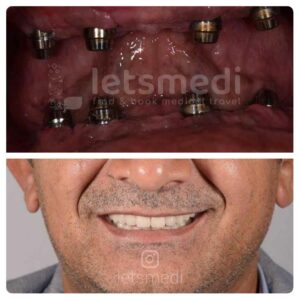
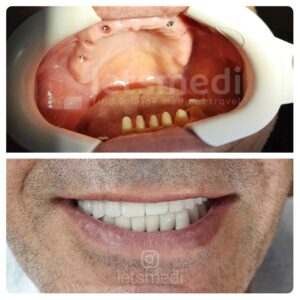
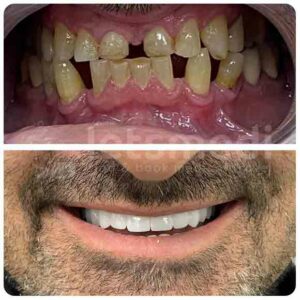
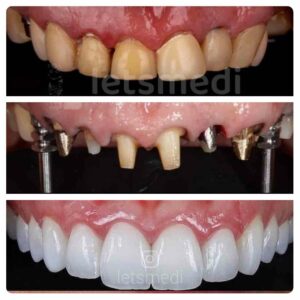
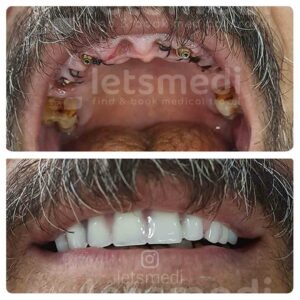
Dental Implants Turkey Reviews





Dental Implants Turkey FAQ
Is Turkey a good place for dental implants?
Tooth loss caused by various reasons has a negative impact on all aspects of our lives. If we encounter difficulties in aesthetics, diet and communication, then there is a solution to tooth loss. Thousands of patients who received dental implant treatment in Turkey got rid of all these problems in a short time.
Is it more affordable to get dental implant in Turkey?
The price of dental implants in Turkey includes the cost of dental implants, abutments, veneers and surgery. Many factors such as the number of implants, the brand of the implant, the clinic where the treatment is performed, the experience of the dentist, the structure of the patient’s mouth and teeth, and whether the jaw is sufficient, etc., will affect the price of the implant.
Does medical insurance cover Dental Implants?
The basic dental insurance policy usually does not cover dental implant surgery. You will need to consider the coverage of cosmetic dental surgery, which covers part of the implant. Your implant insurance may be 50% of the cost, which means your insurance covers half of the surgery.
How long do dental implants take in Turkey?
For a one-time implant operation, it takes 10 minutes to 30 minutes to complete. The duration of implant treatment can also vary from half an hour to several hours, depending on the number of implants to be performed and the patient’s jaw. After the operation, the implant and bone need 1 to 3 months to adjust. When fused with bone, the prosthesis placed on the implant is completed in several courses.
Is Turkey good for dental implant?
Counterfeit dental implants and poor quality materials are a common problem in the cheap tooth extraction and prosthetic services offered in some dental clinics. Screws used in implant surgery may not meet the appropriate standards, leading to hazards and complications in prosthetics. Inadequate sterilisation practices and poor quality surgical techniques can also contribute to infections and failure of cheap dental implants.
Get Information Now

Luna
Medical Travel advisor





